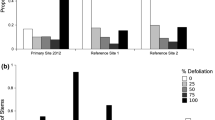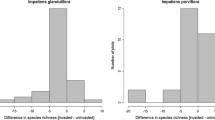Abstract
Long-term pre-release evaluations of how invasive plants respond to herbivory in introduced ranges can help identify the most effective biological control agents. However, most evaluations have been conducted within only one generation of introduced invasive species. This study tested effects across seven generations of simulated herbivory (i.e., defoliation) and habitat types on the invasive weed Alternanthera philoxeroides. We found total biomass of A. philoxeroides was decreased by defoliation during the first three generations when grown in a simulated aquatic habitat, but was decreased by defoliation only in the first generation when grown in a simulated terrestrial habitat. Defoliation significantly decreased stem diameter and collenchyma thickness and increased cortex thickness and total phenol production in A. philoxeroides grown in a simulated terrestrial or aquatic habitat during the first generation, but showed little effect during the following six successive generations. The associations between stem anatomical structural parameters and biomass significantly differed between non-defoliation and defoliation treatments in the simulated aquatic habitat, but not in the simulated terrestrial habitat. Our results suggest simulated herbivory exerted successful biological control on A. philoxeroides during the first generation in a simulated terrestrial habitat and the first three generations in a simulated aquatic habitat, but failed to restrain the vegetative offspring of A. philoxeroides. This failure of long-term biological control on A. philoxeroides might be caused by changes in the stem anatomical structure and compensatory growth. Our study highlights the need for long-term pre-release evaluation when testing the efficiency of biological control agents.


Similar content being viewed by others
Data availability
Data are available on reasonable request.
References
Ackerly DD, Dudley SA, Sultan SE et al (2000) The evolution of plant ecophysiological traits: recent advances and future directions new research addresses natural selection, genetic constraints, and the adaptive evolution of plant ecophysiological traits. Bioscience 50:979–995
Baldwin IT (1990) Herbivory simulations in ecological research. Trends Ecol Evol 5:91–93
Barbehenn RV, Constabel CP (2011) Tannins in plant–herbivore interactions. Phytochemistry 72:1551–1565
Belsky AJ (1986) Does herbivory benefit plants? A review of the evidence. Am Nat 127:870–892
Bianka S, Thomas G, Margret S (2010) Aerenchyma formation in the rice stem and its promotion by H2O2. New Phytol 190:369–378
Capinera JL, Roltsch WJ (1980) Response of wheat seedlings to actual and simulated migratory grasshopper defoliation. J Econ Entomol 73:258–261
Colpetzer K, Hough-Goldstein J, Harkins KR et al (2004) Feeding and oviposition behavior of Rhinoncomimus latipes Korotyaev (Coleoptera: Curculionidae) and its predicted effectiveness as a biological control agent for Polygonum perfoliatum L. (Polygonales: Polygonaceae). Environ Entomol 33:990–996
Cowie BW, Venturi G, Witkowski ETF et al (2016) Does climate constrain the spread of Anthonomus santacruzi, a biological control agent of Solanum mauritianum, in South Africa? Biol Control 101:1–7
Dong BC, Aplert P, Guo W et al (2012) Effects of fragmentation on the survival and growth of the invasive, clonal plant Alternanthera philoxeroides. Biol Invasions 14:1101–1110
Dong BC, Fu T, Luo FL et al (2017) Herbivory-induced maternal effects on growth and defense traits in the clonal species Alternanthera philoxeroides. Sci Total Environ 605:114–123
Du L, Yang B, Guan W et al (2016) Phenotypic variation and water selection potential in the stem structure of invasive alligator weed. Acta Oecol Int J Ecol 71:22–30
Du L, Liu H, Guan W et al (2019) Drought affects the coordination of belowground and aboveground resource-related traits in Solidago canadensis in China. Ecol Evol 3:3. https://doi.org/10.1002/ece3.5536
Dudley SA, Schmitt J (1996) Testing the adaptive plasticity hypothesis: density-dependent selection on manipulated stem length in Impatiens capensis. Am Nat 147:445–465
Fine PVA, Miller ZJ, Mesones I et al (2006) The growth-defense trade-off and habitat specialization by plants in Amazonian forests. Ecology 87:S150–S162
Franks SJ, Kral AM, Pratt PD (2006) Herbivory by introduced insects reduces growth and survival of Melaleuca quinquenervia seedlings. Environ Entomol 35:366–372
Gilpin M (1990) Biological invasions—a global perspective. Science 248:88–89
Gioria M, Osborne BA (2014) Resource competition in plant invasions: emerging patterns and research needs. Front Plant Sci 5:1–21
Griffith TC, Paterson ID, Owen CA et al (2019) Thermal plasticity and microevolution enhance establishment success and persistence of a water hyacinth biological control agent. Entomol Exp Appl 167:616–625
Herms DA, Mattson WJ (1992) The dilemma of plants: to grow or defend. Q Rev Biol 67:283–335
Hogg BN, Moran PJ, Smith L (2016) Multi-generational impacts of the psyllid Arytinnis hakani (Hemiptera: Psyllidae) on growth and survival of the invasive weed Genista monspessulana. Biol Control 100:87–93
Hough-Goldstein J, LaCoss SJ (2012) Interactive effects of light environment and herbivory on growth and productivity of an invasive annual vine, Persicaria perfoliata. Arthropod Plant Interact 6:103–112
Huang W, Siemann E, Wheeler GS et al (2010) Resource allocation to defence and growth are driven by different responses to generalist and specialist herbivory in an invasive plant. J Ecol 98:1157–1167
Jin Z, Li J, Zhu X (2006) Analysis of the total phenols content in differentorgans of Calycanthus chinensis from different habitat. J Anhui Agric Univ 33:454–457
Julien MH, Skarratt B, Maywald GF (1995) Potential geographical distribution of alligator weed and its biological-control by Agasicles hygrophila. J Aquat Plant Manag 33:55–60
Julien M, Sosa A, Chan R et al (2012) Alternanthera philoxeroides (Martius) Grisebach-alligator weed. In: Julien M, McFadyen R, Cullen J (eds) Biological Control of Weeds in Australia. CSIRO Publishing, Australia, pp 43–51
Kumaran N, Lockett C, Dhileepan K (2018) Effect of simulated herbivory on bellyache bush (Jatropha gossypiifolia L.) growth and implications for biological control. Weed Biol Manag 18:151–159
Lehtilä K, Boalt E (2004) The use and usefulness of artificial herbivory in plant-herbivore studies. In: Weisser WW, Siemann E (eds) Ecological studies, vol. 173: insects and ecosystem function. Springer, Berlin, pp 257–275
Leroux O (2012) Collenchyma: a versatile mechanical tissue with dynamic cell walls. Ann Bot 110:1083–1098
Li B, Tomoko S, Yasuhiro Y et al (2001) Interclonal differences, plasticity and trade-offs of life history traits of Cyperus esculentus in relation to water availability. Plant Species Biol 16:193–207
Li JM, Jin ZX, Zhu XY (2007) Comparison of the total tannin in different organs of Calycanthus chinensis. Guihaia 27:944–947
Louda SM, Pemberton RW, Johnson MT et al (2003) Nontarget effects—the Achilles’ heel of biological control? Retrospective analyses to reduce risk associated with biocontrol introductions. Annu Rev Entomol 48:365–396
Lu X, Siemann E, Shao X et al (2013) Climate warming affects biological invasions by shifting interactions of plants and herbivores. Glob Change Biol 19:2339–2347
Lu X, Siemann E, He M et al (2015) Climate warming increases biological control agent impact on a non-target species. Ecol Lett 18:48–56
Lu X, He M, Tang S et al (2019) Herbivory may promote a non-native plant invasion at low but not high latitudes. Ann Bot 124:819–827
Ma R, Ding J, Wang R (2003) Population adaptability of Agasicles hygrophila on different ecotypes alligaorweed. Chin J Biol Control 19:54–58
Mukherjee A, Jones JW, Cuda JP et al (2012) Effect of simulated herbivory on growth of the invasive weed Hygrophila polysperma: experimental and predictive approaches. Biol Control 60:271–279
Müller-Schärer H, Schaffner U (2008) Classical biological control: exploiting enemy escape to manage plant invasions. Biol Invasions 10:859–874
Nault BA, Kennedy GG (1998) Limitations of using regression and mean separation analyses for describing the response of crop yield to defoliation: a case study of the Colorado potato beetle (Coleoptera: Chrysomelidae) on potato. J Econ Entomol 91:7–20
Pan X, Geng Y, Zhang W et al (2006) The influence of abiotic stress and phenotypic plasticity on the distribution of invasive Alternanthera philoxeroides along a riparian zone. Acta Oecol 30:341
Raghu S, Dhileepan K (2005) The value of simulating herbivory in selecting effective weed biological control agents. Biol Control 34:265–273
Schooler S, Baron Z, Julien M (2006) Effect of simulated and actual herbivory on alligator weed, Alternanthera philoxeroides, growth and reproduction. Biol Control 36:74–79
Schwarzlander M, Hinz HL, Winston RL et al (2018) Biological control of weeds: an analysis of introductions, rates of establishment and estimates of success, worldwide. Biocontrol 63:319–331
Sun Y, Ding J, Ren M (2009) Effects of simulated herbivory and resource availability on the invasive plant, Alternanthera philoxeroides in different habitats. Biol Control 48:287–293
Sutton GF, Klein H, Paterson ID (2018) Evaluating the efficacy of Hypogeococcus sp as a biological control agent of the cactaceous weed Cereus jamacaru in South Africa. Biocontrol 63:493–503
Thomas MB, Reid AM (2007) Are exotic natural enemies an effective way of controlling invasive plants? Trends Ecol Evol 22:447–453
Tong W, Hu J, Wang R et al (2018) Tolerance and resistance facilitate the invasion success of Alternanthera philoxeroides in disturbed habitats: a reconsideration of the disturbance hypothesis in the light of phenotypic variation. Environ Exp Bot 153:135–142
TrumbleKolodny-Hirsch JTDM, Ting IP (2003) Plant compensation for arthropod herbivory. Annu Rev Entomol 38:93–120
Vitousek PM, D’Antonio CM, Loope LL et al (1996) Biological invasions as global environmental change. Am Sci 84:468–478
Wan JL, Huang B, Yu H et al (2019) Reassociation of an invasive plant with its specialist herbivore provides a test of the shifting defence hypothesis. J Ecol 107:361–371
Wang N, Yu FH, Li PX et al (2009) Clonal integration supports the expansion from terrestrial to aquatic environments of the amphibious stoloniferous herb Alternanthera philoxeroides. Plant Biol 11:483–489
Wei H, Lu X, Ding J (2015) Direct and indirect impacts of different water regimes on the invasive plant, alligator weed (Alternanthera philoxeroides), and its biological control agent, Agasicles hygrophila. Weed Biol Manag 15:1–10
Williams DG, Mack RN, Black RA (1995) Ecophysiology of introduced Pennisetum setaceum on Hawaii: the role of phenotypic plasticity. Ecology 76:1569–1580
Williamson M (1996) Biological Invasions. In: Usher MB, Deangelis DL, Manly BJF (eds) Population and Community Biology Series 15. Chapman & Hall, London, pp 1–244
Xiong S, Zuo X, Zhu Y (2005) Determination of cellulose, hemicellulose and lignin in rice husk. Cereal Feed Ind 5:40–41
Yu H, Fan S (2018) Differences in physiological traits and resistances of Alternanthera philoxeroides after herbivory by generalists and specialists. Aquat Ecol 52:323–332
Zhen S, Ruihai Z, Guoliang Z et al (2018) The effect of Agasicles hygrophila release on the control of Alternanthera philoxeroides. Ecol Environ Sci 28:2033–2038
Zong N, Shi P (2019) Nitrogen addition stimulated compensatory growth responses to clipping defoliation in a Northern Tibetan alpine meadow. Grassl Sci 65:60–68
Zuo SP, Ma YQ, Shinobu I (2012) Differences in ecological and allelopathic traits among Alternanthera philoxeroides populations. Weed Biol Manag 12:123–130
Acknowledgements
This study was financially supported by the Ten Thousand Talent Program of Zhejiang Province (2019R52043), the National Key Research and Development Program of China (No. 2016YFC1201100) and the National Natural Science Foundation of China (No. 31270461).
Author information
Authors and Affiliations
Contributions
JL directed the research. SG conducted the experiments. YY analyzed data. JL, MY and YY prepared the manuscript.
Corresponding author
Ethics declarations
Conflict of interest
The authors declare that they have no conflict of interest.
Additional information
Publisher's Note
Springer Nature remains neutral with regard to jurisdictional claims in published maps and institutional affiliations.
Rights and permissions
About this article
Cite this article
Yuan, Y., Guo, S., Yan, M. et al. Multi-generational effects of simulated herbivory and habitat types on the invasive weed Alternanthera philoxeroides: implications for biological control. Biol Invasions 23, 2109–2123 (2021). https://doi.org/10.1007/s10530-021-02491-x
Received:
Accepted:
Published:
Issue Date:
DOI: https://doi.org/10.1007/s10530-021-02491-x




